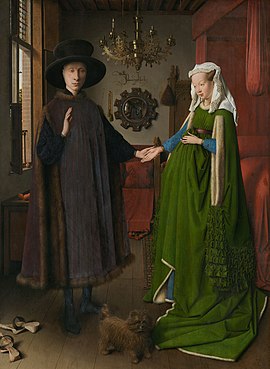 Global Information
Global InformationArnolfini Portrait information
| The Arnolfini Portrait | |
|---|---|
 | |
| Artist | Jan van Eyck |
| Year | 1434 |
| Type | Oil on oak panel of 3 vertical boards |
| Dimensions | 82.2 cm × 60 cm (32.4 in × 23.6 in); panel 84.5 cm × 62.5 cm (33.3 in × 24.6 in) |
| Location | National Gallery, London |
The Arnolfini Portrait (or The Arnolfini Wedding, The Arnolfini Marriage, the Portrait of Giovanni Arnolfini and his Wife, or other titles) is a 1434 oil painting on oak panel by the Early Netherlandish painter Jan van Eyck. It forms a full-length double portrait, believed to depict the Italian merchant Giovanni di Nicolao Arnolfini and his wife, presumably in their residence at the Flemish city of Bruges.
It is considered one of the most original and complex paintings in Western art, because of its beauty, complex iconography,[1] geometric orthogonal perspective,[2] and expansion of the picture space with the use of a mirror.[3][4] According to Ernst Gombrich "in its own way it was as new and revolutionary as Donatello's or Masaccio's work in Italy. A simple corner of the real world had suddenly been fixed on to a panel as if by magic... For the first time in history the artist became the perfect eye-witness in the truest sense of the term".[5] The portrait has been considered by Erwin Panofsky and some other art historians as a unique form of marriage contract, recorded as a painting.[6] Signed and dated by van Eyck in 1434, it is, with the Ghent Altarpiece by the same artist and his brother Hubert, the oldest very famous panel painting to have been executed in oils rather than in tempera. The painting was bought by the National Gallery in London in 1842.
Van Eyck used the technique of applying several layers of thin translucent glazes to create a painting with an intensity of both tone and colour. The glowing colours also help to highlight the realism, and to show the material wealth and opulence of Arnolfini's world. Van Eyck took advantage of the longer drying time of oil paint, compared to tempera, to blend colours by painting wet-in-wet to achieve subtle variations in light and shade to heighten the illusion of three-dimensional forms. The wet-in-wet (wet-on-wet), technique, also known as alla prima, was highly utilized by Renaissance painters including Jan van Eyck.[7] The medium of oil paint also permitted van Eyck to capture surface appearance and distinguish textures precisely. He also rendered the effects of both direct and diffuse light by showing the light from the window on the left reflected by various surfaces. It has been suggested that he used a magnifying glass in order to paint the minute details such as the individual highlights on each of the amber beads hanging beside the mirror.
The illusionism of the painting was remarkable for its time, in part for the rendering of detail, but particularly for the use of light to evoke space in an interior, for "its utterly convincing depiction of a room, as well of the people who inhabit it".[8] Whatever meaning is given to the scene and its details, and there has been much debate on this, according to Craig Harbison the painting "is the only fifteenth-century Northern panel to survive in which the artist's contemporaries are shown engaged in some sort of action in a contemporary interior. It is indeed tempting to call this the first genre painting – a painting of everyday life – of modern times".
- ^ Ward, John. "Disguised Symbolism as Enactive Symbolism in Van Eyck's Paintings". Artibus et Historiae, Vol. 15, No. 29 (1994), pp. 9–53
- ^ Elkins, James, "On the Arnolfini Portrait and the Lucca Madonna: Did Jan van Eyck Have a Perspectival System?". The Art Bulletin, Vol. 73, No. 1 (March 1991), pp. 53–62
- ^ Ward, John L. "On the Mathematics of the Perspective of the "Arnolfini Portrait" and similar works of Jan van Eyck", Art Bulletin, Vol. 65, No. 4 (1983) p.680
- ^ Seidel, Linda. "Jan van Eyck's Arnolfini Portrait": Business as Usual?". Critical Inquiry, Vol. 16, No. 1 (Autumn, 1989), pp. 54–86
- ^ Gombrich, E.H., The Story of Art, p. 180, Phaidon, 13th edn. 1982. ISBN 0-7148-1841-0
- ^ Harbison, Craig. "Sexuality and Social Standing in Arnolfini's Double Portrait". Renaissance Quarterly, Vol. 43, No. 2 (Summer, 1990), pp. 249–291
- ^ "The Arnolfini Portrait by Jan van Eyck". Articonog. Archived from the original on 2020-06-27. Retrieved 2020-06-27.
- ^ Dunkerton, Jill, et al., Giotto to Dürer: Early Renaissance Painting in the National Gallery, page 258. National Gallery Publications, 1991. ISBN 0-300-05070-4